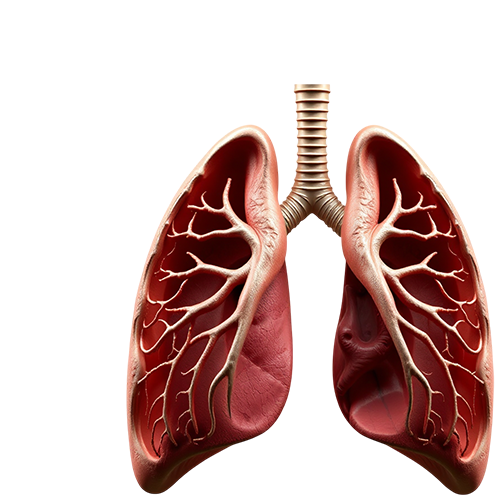Diseases that target the pulmonary system and influence the functioning of the lungs and other respiratory tract components are termed pulmonary disorders or pulmonary diseases. Air pollutants, such as asbestos, radon, secondhand smoke, and smoking, can all lead to respiratory ailments. Various infections are responsible for causing respiratory diseases. Asthma, lung cancer, pulmonary fibrosis, pneumonia, and COPD are among the conditions of respiratory disorders.
Since chronic respiratory diseases(CRDs) are the primary cause of disability and death, they have a significant detrimental effect on the health of millions of people. Because of these facts, health authorities are required to employ a coordinated approach that involves integrating international health policies and disease management strategies facilitating in-depth research in this area.


The following are some of the respiratory infection symptoms:

Smoke toxins damage the walls of the lung's alveoli(alveolar membrane). As a result, oxygen cannot be appropriately absorbed into the blood. Thus, the patients may face discomfort, breathing difficulty and will have to suffer from respiratory problems.

Both indoor and outdoor air pollution expose people to harmful air pollutants, which can lead to respiratory health issues. NO2, ozone, PM, and VOCs are common pollutants that are harmful to the respiratory tract, increasing the possibility of respiratory infections.

Among the sources are dust mites, pollen, mould, cat dander, and certain foods. Exposure to these substances often leads to allergic reactions, which in turn increases the chance of contracting respiratory diseases.

The occupations that may increase the risk of respiratory diseases are where individuals are required to deal with hazardous elements like asbestos, silica, coal dust, and other similar toxins. In addition to other respiratory conditions, prolonged exposure to these substances can cause pneumoconiosis, occupational asthma, and COPD associated with the workplace.

While there are bacterial and viral infections that may lead to respiratory syncytial virus (RSV), influenza, pneumonia, and TB which are all related to lung and airway inflammation.
Asthma is a chronic condition and a disease that causes the airways in the lungs to become inflamed, blocked, and swollen. Excess mucus is produced, which makes breathing difficult. It is a chronic disorder of the lungs that manifests as recurrent tightness of the chest, whistling sound out of the lungs, excess mucus, and shortness of breath. The factors that trigger asthma can be very diverse and might be anything from exercise to infections like cold or something present in the air like cigarettes or pollution.
A cough that persists for more than two months ends up as a chronic cough. It may manifest through a variety of symptoms, including a stuffy nose, shortness of breath, and an excessive amount of mucus at the back of the throat. It isn't a disease itself but a symptom of underlying health conditions, with post nasal drip, acid reflux, and asthma being the common causes.
Severe shortness of breath may occur due to pulmonary fibrosis, which causes lung scarring, commonly known as interstitial lung disease. The scarification and stiffening of the lungs make it harder for oxygen to reach the bloodstream. A number of different disorders, some medications, heredity, and breathing in hazardous substances may be the reasons why pulmonary fibrosis starts.
In this the lungs have a hard time expelling carbon dioxide from the body and inhaling oxygen as could be seen with acute pneumonia and chronic pneumonia. In bronchitis, a person gets inflamed bronchial tubes, which are the passage for air in and out of the lungs, and as expected, are also covered by mucus.
Homeopathy is a holistic medical system that rests on the principle "Similia similebus curantur", which means similarity of symptoms with the respiratory infection treatment. Homeopaths use the holistic approach to diagnose the condition, which includes life-style, environment, personality, and medical-history. Homeopathic remedies for respiratory tract infection treatment make use of the ‘Similia similebus curantur'(let likes be cured by likes) principle, and are prepared on the basis of symptoms, as each individual is unique. There are homeopathic remedies that serve very well in all cases of chronic form of respiratory infections.









